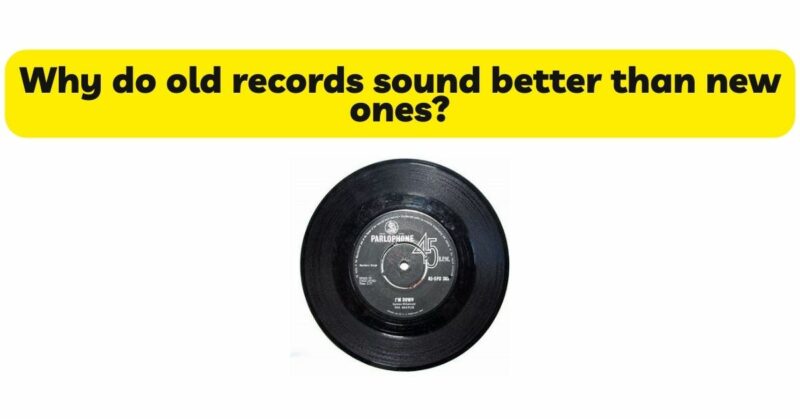Vinyl records have long been revered for their unique and captivating sound, with many enthusiasts claiming that older records possess a certain charm and audio quality that surpasses that of their newer counterparts. In this article, we delve into the reasons why old records are often perceived to sound better, considering factors such as manufacturing techniques, analog warmth, mastering processes, and personal nostalgia. By understanding these elements, we aim to shed light on the enduring allure of vintage vinyl records and the subjective experience they offer.
Analog Warmth and Character: One of the primary reasons why old records are often celebrated for their sound quality is the inherent analog warmth and character they possess. Older recordings were predominantly captured and reproduced using analog equipment, which imbued them with a rich, organic, and warm sonic quality. The inherent imperfections of analog technology, including subtle distortions and harmonics, contributed to a unique audio experience that some listeners find more pleasing and immersive.
Manufacturing Techniques: The manufacturing techniques employed for older records differed from those used today. Older records were often pressed using traditional analog processes that allowed for more dynamic and nuanced sound reproduction. These manufacturing methods, combined with the use of high-quality vinyl formulations, contributed to the overall sonic appeal of vintage records. Some argue that the handcrafted nature of older records, with their individualized attention and meticulous manufacturing, adds to their distinctive sound.
Mastering Processes: Mastering, the final stage in the production of a vinyl record, plays a crucial role in shaping its sound. Older records often benefited from mastering techniques that were tailored to vinyl playback. Mastering engineers of the past had extensive experience and understanding of vinyl’s unique characteristics, allowing them to optimize the audio specifically for the medium. This expertise in vinyl mastering contributed to the exceptional sound quality found in many vintage records.
Dynamic Range and Compression: Older records typically had a wider dynamic range, meaning they could capture and reproduce a greater range of sound, from the softest whispers to the loudest crescendos. This dynamic range was partly due to the mastering techniques employed and the limitations of analog equipment. In contrast, some argue that modern mastering practices, driven by the loudness war and the desire to maximize volume, have led to increased compression, resulting in a loss of dynamic range and subtle details.
Vinyl Formulations and Durability: Vinyl formulations used in the past were often of higher quality than those used in mass-produced records today. Older records were commonly pressed with thicker and more robust vinyl, which contributed to better sound quality and durability over time. The use of higher-quality materials helped reduce surface noise and playback issues commonly associated with vinyl records. In contrast, the pursuit of cost-efficiency in modern production has led to thinner and less durable vinyl formulations.
Nostalgia and Perception: The perception of sound quality is highly subjective and influenced by personal experiences and nostalgia. For many, the allure of old records lies not only in the sound they produce but also in the memories and emotions associated with them. The crackle and pops that accompany vintage vinyl playback evoke a sense of nostalgia and transport listeners back to a time when music was experienced in a different way. This emotional connection often enhances the perceived sound quality of older records.
Individual Preferences and Listening Equipment: Ultimately, the preference for old records over new ones is a matter of personal taste. Some listeners genuinely prefer the sonic characteristics of vintage vinyl, while others appreciate the cleaner, more precise sound of modern pressings. Additionally, the quality of the playback equipment, including turntables, cartridges, amplifiers, and speakers, can significantly impact the perceived sound quality of vinyl records, regardless of their age.
Conclusion: While the notion that old records sound better than new ones is subjective and influenced by personal preferences, there are tangible factors that contribute to the enduring appeal of vintage vinyl. The analog warmth, manufacturing techniques, mastering processes, dynamic range, vinyl formulations, and personal nostalgia associated with older records all play a role in shaping their sonic charm. However, it is important to acknowledge that advancements in modern vinyl production have allowed for high-quality new releases that can rival the sound of their predecessors. Ultimately, the magic of vinyl lies in the diverse listening experiences it offers, whether through the crackle of an old gem or the pristine fidelity of a modern masterpiece.


